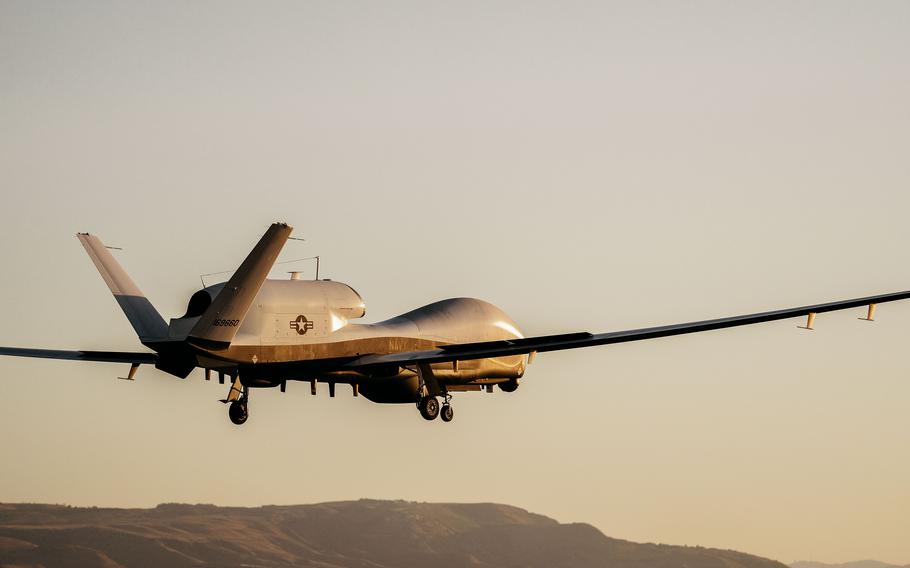
An MQ-4C Triton prepares to land at Naval Air Station Sigonella in Italy on July 2, 2024. The Triton's maker, Northrop Grumman, saw a 5.8% increase in revenues, reaching $35.6 billion as arms sales surged globally in 2023, according to a new report. (Alex Delgado/U.S. Navy)
The world’s 100 largest defense companies increased their combined revenues from sales of arms and military services by 4.2% last year, totaling $632 billion, according to a report released Monday by the Stockholm International Peace Research Institute.
Every region of the world covered by the ranking saw a rise in arms revenue, amid ongoing fighting in the Middle East and Ukraine and heightened tensions in East Asia. The uptick is likely to continue in 2024, SIPRI researcher Lorenzo Scarazzato said Monday.
“The current demand has not yet been fully reflected in sales figures, as many companies are struggling with backlogs and production limitations,” Scarazzato said.
U.S.-based companies continued to dominate the arms industry, accounting for half of the total sales by the top 100 defense firms.
The combined revenues of the 41 U.S. companies on the list grew by 2.5% to $317 billion, with 30 of the companies recording year-on-year increases.
Lockheed Martin and RTX, formerly Raytheon Technologies, maintained their positions as the top two arms producers but reported slight declines in arms revenues for 2023, with persistent supply chain issues cited as a key factor.
Lockheed Martin’s revenues fell for the third consecutive year, dropping to $60.8 billion, while RTX’s revenues declined to $40.7 billion, particularly impacting missile and aerospace equipment production.
Northrop Grumman, the world’s third-largest arms producer, saw a 5.8% increase in revenues, reaching $35.6 billion.
Other major U.S. firms, such as Boeing and General Dynamics, posted modest revenue increases of 2.0% and 3.2%, respectively.
However, production of complex weapon systems, particularly in the aeronautical and missile defense sectors, faced delays due to supply chain disruptions, including reduced access to raw materials since Russia’s 2022 invasion of Ukraine.

A Polish M1 Abrams tank traverses muddy terrain in the Nowa Deba Training Area in Poland on Jan. 31, 2024. Arms revenues were up worldwide last year, including for the Abrams tank's manufacturer, General Dynamics, according to a newly released report. (Trevares Johnson/U.S. Army)
U.S. defense companies in the lower half of the top 100 outperformed many of their larger counterparts, as their shorter supply chains and simpler production processes allowed them to scale up quickly to meet growing demand, SIPRI said.
Russia saw the most significant increase in arms revenues among any area. The two Russian companies listed in SIPRI’s top 100, state-owned Rostec and United Shipbuilding Corp., recorded a combined 40% increase in sales to an estimated $25.5 billion.
“While official data on Russian arms production is scarce, most analysts agree that new military equipment production ramped up substantially in 2023, with existing arsenals undergoing extensive refurbishment,” SIPRI researcher Nan Tian said.
Conversely, European companies outside Russia recorded the smallest regional increase in arms revenues, with a combined growth of 0.2%, to $133 billion.
Researchers noted that many European firms were fulfilling older contracts, meaning their 2023 revenues didn’t fully reflect the surge in new orders driven by the war in Ukraine.
Companies in Germany, Poland, Sweden and other nations producing ammunition, artillery and air defense systems saw substantial growth.
For example, demand for land-based weapons systems and munitions surged as European governments bolstered their defenses in response to Russia’s aggression.
In the Middle East, defense firms posted an 18% increase in arms revenues, reaching $19.6 billion.
The three Israeli companies on SIPRI’s list reported record-breaking sales, with revenues rising 15% to $13.6 billion. The ongoing war in Gaza fueled unprecedented demand for Israeli-produced weapons, with further growth expected as the conflict persists.
Defense companies in Asia and Oceania recorded a 5.7% increase in revenues to $136 billion.
South Korean firms saw particularly sharp growth, with revenues rising 39% to $11 billion, as they expanded their global market share and supplied weapons to Ukraine.
Japan’s arms revenues grew by 35% to $10 billion, driven by a domestic military buildup and a surge in orders.
China, home to nine companies in the top 100, recorded its smallest annual increase since 2019, with revenues growing just 0.7% to $103 billion amid a slowing economy.
SIPRI’s annual report is based on data from its Arms Industry Database.